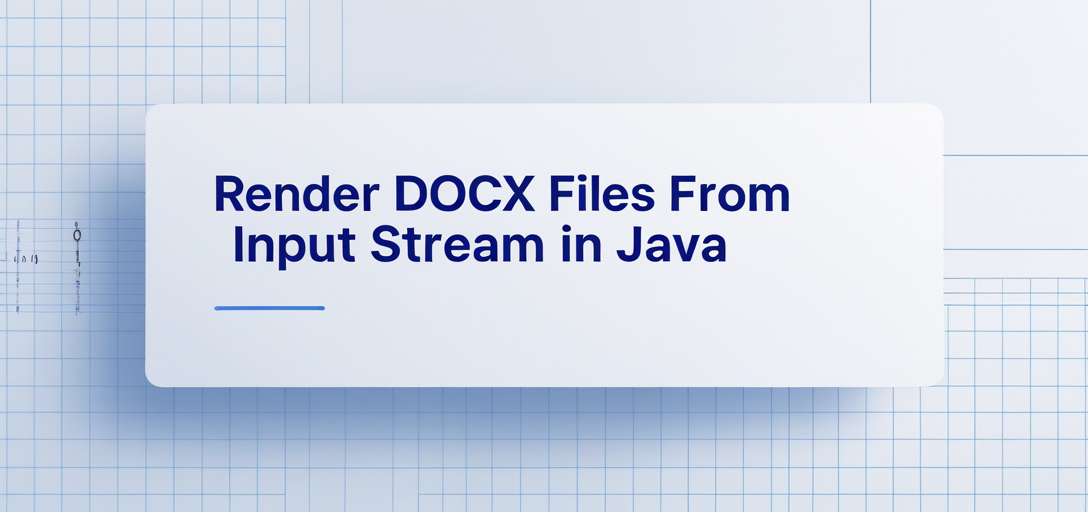How to Load and Render a DOCX File from an InputStream Using GroupDocs.Viewer for Java
Introduction
In the digital era, rendering documents seamlessly within applications is essential for providing smooth user experiences. Whether you’re developing enterprise solutions or web-based document management systems, handling file formats like DOCX in real-time can be challenging. GroupDocs.Viewer for Java simplifies this process with its robust features and ease of use.

This tutorial guides you through loading and rendering a DOCX file directly from an InputStream using GroupDocs.Viewer for Java, ideal for scenarios where documents are streamed or generated on-the-fly.
What You’ll Learn:
- Setting up GroupDocs.Viewer for Java in your project.
- Loading a DOCX document from an
InputStream. - Rendering the document into HTML format with embedded resources.
- Practical applications and performance considerations.
Let’s enhance your application’s document handling capabilities by leveraging this powerful tool.
Prerequisites
Before starting, ensure you have the following prerequisites:
Required Libraries
- GroupDocs.Viewer for Java version 25.2 or later.
- A compatible JDK (Java Development Kit).
Environment Setup Requirements
- An IDE such as IntelliJ IDEA or Eclipse to write and run your Java code.
Knowledge Prerequisites
- Basic understanding of Java programming.
- Familiarity with handling streams in Java.
Setting Up GroupDocs.Viewer for Java
To begin, set up the GroupDocs.Viewer library in your project. If you’re using Maven as your build automation tool, follow these steps:
Maven Setup:
Add the following repository and dependency configurations to your pom.xml file:
<repositories>
<repository>
<id>repository.groupdocs.com</id>
<name>GroupDocs Repository</name>
<url>https://releases.groupdocs.com/viewer/java/</url>
</repository>
</repositories>
<dependencies>
<dependency>
<groupId>com.groupdocs</groupId>
<artifactId>groupdocs-viewer</artifactId>
<version>25.2</version>
</dependency>
</dependencies>
License Acquisition
GroupDocs.Viewer offers a free trial to explore its capabilities. For extended use, acquire a temporary license or purchase a full version:
- Free Trial: Download the library and start experimenting.
- Temporary License: Useful for in-depth evaluation without limitations. Get Temporary License
- Purchase: For production environments, purchase a license from GroupDocs to unlock all features.
Basic Initialization
Once your environment is set up and dependencies are resolved, initialize the Viewer object as shown below:
import com.groupdocs.viewer.Viewer;
import java.io.InputStream;
// Initialize with an InputStream
try (InputStream fileStream = new FileInputStream("path/to/your/document.docx")) {
try (Viewer viewer = new Viewer(fileStream)) {
// Additional configurations will follow here.
}
}
Implementation Guide
Now, implement the core feature of loading and rendering a DOCX document from an InputStream.
Feature: Loading Document from Stream
This section demonstrates how to render a DOCX file using GroupDocs.Viewer for Java. This approach is beneficial when handling documents that are not stored locally but need processing on-the-fly.
Step 1: Define Output Path and View Options
First, specify where the output HTML files will be saved and configure view options for rendering:
import com.groupdocs.viewer.options.HtmlViewOptions;
import java.nio.file.Path;
import java.nio.file.Paths;
// Define the output directory and page file path format
Path outputDirectory = Paths.get("output_directory_path");
Path pageFilePathFormat = outputDirectory.resolve("page_{0}.html");
HtmlViewOptions viewOptions = HtmlViewOptions.forEmbeddedResources(pageFilePathFormat);
Step 2: Load Document from InputStream
Create a Viewer instance using an InputStream. This approach is ideal for handling documents received as streams:
import java.io.FileInputStream;
import java.io.IOException;
// Use FileInputStream to load the DOCX file into an InputStream
try (InputStream inputStream = new FileInputStream("path/to/your/document.docx")) {
try (Viewer viewer = new Viewer(inputStream)) {
// Render the document in HTML format with embedded resources
viewer.view(viewOptions);
}
} catch (IOException e) {
throw new RuntimeException("Error loading document from stream", e);
}
Explanation of Parameters
HtmlViewOptions.forEmbeddedResources(pageFilePathFormat)creates options to save each page as an individual HTML file with all resources embedded.- The
try-with-resourcesstatement ensures that both theInputStreamandViewerobjects are closed automatically, preventing resource leaks.
Practical Applications
GroupDocs.Viewer for Java is versatile and can be used in various scenarios:
- Web Document Management: Render documents dynamically on web applications without needing to store them locally.
- Email Attachments Previewing: Quickly convert email attachments into viewable formats within an application.
- Cloud Storage Integration: Stream documents from cloud storage solutions like AWS S3 or Azure Blob Storage directly into your app.
Performance Considerations
When dealing with large document files, consider the following tips to optimize performance:
- Use appropriate JVM memory settings to handle larger documents efficiently.
- Cache rendered HTML pages if they need to be accessed frequently.
- Monitor resource usage and adjust thread pools in concurrent environments to balance load effectively.
Conclusion
In this tutorial, we covered how to load and render DOCX files from an InputStream using GroupDocs.Viewer for Java. This approach is ideal for applications requiring dynamic document rendering without reliance on local storage.
Next Steps
- Explore more advanced features of GroupDocs.Viewer.
- Integrate GroupDocs.Viewer with your preferred cloud storage or database solutions.
- Experiment with different file formats supported by the library.
Call to Action: Implement this solution in your next project and see how it streamlines document handling!
FAQ Section
How do I render other file types using GroupDocs.Viewer?
- GroupDocs.Viewer supports multiple formats like PDF, XLSX, PPTX, etc. Check the API Reference for details.
Can I customize the output HTML files?
- Yes, you can use various options provided by
HtmlViewOptionsto tailor the rendering process.
- Yes, you can use various options provided by
What are common troubleshooting tips if my documents don’t render correctly?
- Ensure all dependencies are properly configured. Verify that file paths and streams are correctly initialized.
Is there a performance impact when using GroupDocs.Viewer in high-load environments?
- Proper JVM tuning and resource management can mitigate performance impacts in such scenarios.
How do I handle errors during the rendering process?
- Use try-catch blocks to manage exceptions effectively, especially around file input/output operations.
Resources
For more information on GroupDocs.Viewer for Java: